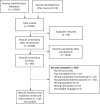Participant characteristics in the prevention of gestational diabetes as evidence for precision medicine: a systematic review and meta-analysis
- PMID: 37794119
- PMCID: PMC10551015
- DOI: 10.1038/s43856-023-00366-x
Participant characteristics in the prevention of gestational diabetes as evidence for precision medicine: a systematic review and meta-analysis
Abstract
Background: Precision prevention involves using the unique characteristics of a particular group to determine their responses to preventive interventions. This study aimed to systematically evaluate the participant characteristics associated with responses to interventions in gestational diabetes mellitus (GDM) prevention.
Methods: We searched MEDLINE, EMBASE, and Pubmed to identify lifestyle (diet, physical activity, or both), metformin, myoinositol/inositol and probiotics interventions of GDM prevention published up to May 24, 2022.
Results: From 10347 studies, 116 studies (n = 40940 women) are included. Physical activity results in greater GDM reduction in participants with a normal body mass index (BMI) at baseline compared to obese BMI (risk ratio, 95% confidence interval: 0.06 [0.03, 0.14] vs 0.68 [0.26, 1.60]). Combined diet and physical activity interventions result in greater GDM reduction in participants without polycystic ovary syndrome (PCOS) than those with PCOS (0.62 [0.47, 0.82] vs 1.12 [0.78-1.61]) and in those without a history of GDM than those with unspecified GDM history (0.62 [0.47, 0.81] vs 0.85 [0.76, 0.95]). Metformin interventions are more effective in participants with PCOS than those with unspecified status (0.38 [0.19, 0.74] vs 0.59 [0.25, 1.43]), or when commenced preconception than during pregnancy (0.21 [0.11, 0.40] vs 1.15 [0.86-1.55]). Parity, history of having a large-for-gestational-age infant or family history of diabetes have no effect on intervention responses.
Conclusions: GDM prevention through metformin or lifestyle differs according to some individual characteristics. Future research should include trials commencing preconception and provide results disaggregated by a priori defined participant characteristics including social and environmental factors, clinical traits, and other novel risk factors to predict GDM prevention through interventions.
Plain language summary
An individual’s characteristics, such as medical, biochemical, social, and behavioural may affect their response to interventions aimed at preventing gestational diabetes, which occurs during pregnancy. Here, we evaluated the published literature on interventions such as diet, lifestyle, drug treatment and nutritional supplement and looked at which individual participant characteristics were associated with response to these interventions. Certain participant characteristics were associated with greater prevention of gestational diabetes through particular treatments. Some interventions were more effective when started prior to conception. Future studies should consider individual characteristics when assessing the effects of preventative measures.
© 2023. Springer Nature Limited.
Conflict of interest statement
The authors declare no competing interests.
Figures
Update of
-
A systematic review and meta-analysis of participant characteristics in the prevention of gestational diabetes: a summary of evidence for precision medicine.medRxiv [Preprint]. 2023 Apr 17:2023.04.16.23288650. doi: 10.1101/2023.04.16.23288650. medRxiv. 2023. Update in: Commun Med (Lond). 2023 Oct 5;3(1):137. doi: 10.1038/s43856-023-00366-x. PMID: 37131714 Free PMC article. Updated. Preprint.
References
Grants and funding
LinkOut - more resources
Full Text Sources


